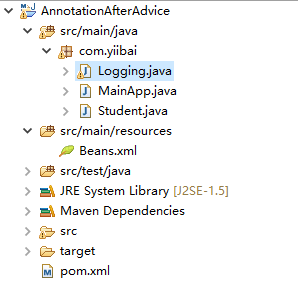Spring AOP基於註解的After Advice
@After是一種通知型別,可確保在方法執行後執行通知。 以下是@After通知類的語法:
語法
@Pointcut("execution(* com.yiibai.Student.getAge(..))")
private void selectGetName(){}
@After("selectGetAge()")
public void afterAdvice(){
System.out.println("Student profile setup completed.");
}
在上面的語法範例中 -
要了解上面提到的@After通知(Advice)相關的概念,我們寫一個Spring AOP基於註解的應用例子,它將使用基於註解組態實現通知。開啟並使用Eclipse IDE,並按照以下步驟建立一個Spring應用程式:
- 更新在Spring AOP應用範例中建立過的
Student專案。 - 更新
bean組態並執行應用程式,如下所述。
整個專案的目錄結構如下所示 -

下面是Logging.java檔案的內容。 這實際上是一個Aspect模組的樣本,它定義了在各個點被呼叫的方法。
package com.yiibai;
import org.aspectj.lang.annotation.Aspect;
import org.aspectj.lang.annotation.Pointcut;
import org.aspectj.lang.annotation.After;
@Aspect
public class Logging {
/** Following is the definition for a pointcut to select
* all the methods available. So advice will be called
* for all the methods.
*/
@Pointcut("execution(* com.yiibai.Student.getAge(..))")
private void selectGetAge(){}
/**
* This is the method which I would like to execute
* after a selected method execution.
*/
@After("selectGetAge()")
public void afterAdvice(){
System.out.println("[afterAdvice] Student profile setup completed.");
}
}
以下是Student.java檔案的內容:
package com.yiibai;
public class Student {
private Integer age;
private String name;
public void setAge(Integer age) {
this.age = age;
}
public Integer getAge() {
System.out.println("Age : " + age );
return age;
}
public void setName(String name) {
this.name = name;
}
public String getName() {
System.out.println("Name : " + name );
return name;
}
public void printThrowException(){
System.out.println("Exception raised");
throw new IllegalArgumentException();
}
}
以下是MainApp.java檔案的內容:
package com.yiibai;
import org.springframework.context.ApplicationContext;
import org.springframework.context.support.ClassPathXmlApplicationContext;
public class MainApp {
public static void main(String[] args) {
ApplicationContext context =
new ClassPathXmlApplicationContext("Beans.xml");
Student student = (Student) context.getBean("student");
student.getName();
student.getAge();
}
}
以下是組態檔案Beans.xml檔案的內容:
<?xml version="1.0" encoding="UTF-8"?>
<beans xmlns="http://www.springframework.org/schema/beans"
xmlns:xsi="http://www.w3.org/2001/XMLSchema-instance"
xmlns:aop="http://www.springframework.org/schema/aop"
xsi:schemaLocation="http://www.springframework.org/schema/beans
http://www.springframework.org/schema/beans/spring-beans-3.0.xsd
http://www.springframework.org/schema/aop
http://www.springframework.org/schema/aop/spring-aop-3.0.xsd ">
<aop:aspectj-autoproxy/>
<!-- Definition for student bean -->
<bean id="student" class="com.yiibai.Student">
<property name="name" value="minsu" />
<property name="age" value="24"/>
</bean>
<!-- Definition for logging aspect -->
<bean id="logging" class="com.yiibai.Logging"/>
</beans>
執行專案
完成建立原始碼和組態檔案後,執行應用程式。右鍵單擊應用程式中的MainApp.java,並使用執行方式作為Java應用程式命令。 如果您的應用程式一切正常,這將列印以下訊息:
Name : minsu
Age : 24
[afterAdvice] Student profile setup completed.
這裡簡單解釋一下上面定義的@Pointcut,它使用一個表示式來選擇在com.yiibai包中定義的類中定義的方法getName()。 @After通知使用上面定義的切入點作為引數。 在上述切入點覆蓋的每個方法之後,都將呼叫afterAdvice()方法。